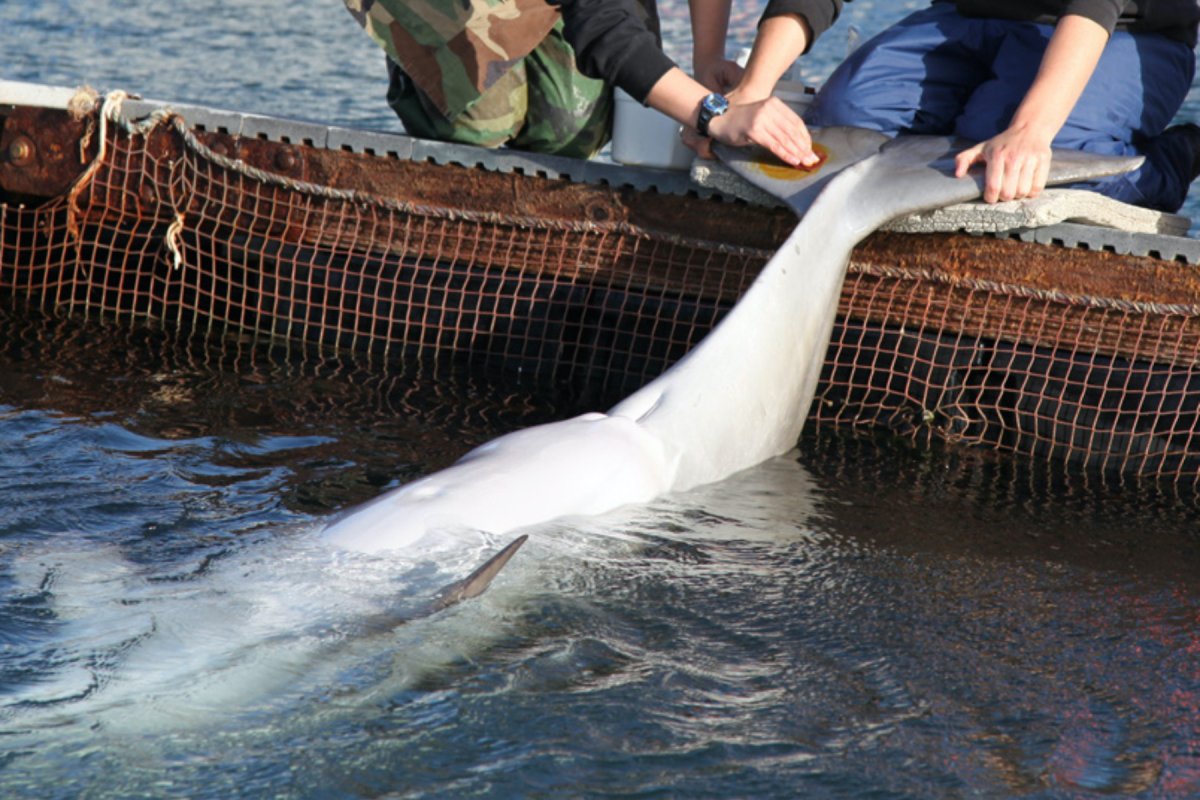Baby dolphins are being fed toxins from a source you might least expect: the milk of their mothers.
The toxic pollutants, including polychlorinated biphenyls (PCBs), DDT and flame retardants, end up in the baby dolphins in higher concentrations than in their mothers, new research in the journal Science of The Total Environment has found.
"The newborns are getting the highest concentrations soon after birth, at the time when they are most vulnerable," Dawn Noren, the study's lead author, said in a statement from the National Oceanic and Atmospheric Administration (NOAA).
"Mammals are still developing neurologically after birth, so high exposure early on is a huge concern," said Noren, who is a research fishery biologist at NOAA Fisheries' Northwest Fisheries Science Center

This is because these persistent organic pollutants (POPs)—which take a long time to break down in the environment—bioaccumulate up the food chain because they are stored in the fatty blubber of marine animals. These chemicals get more and more concentrated in the bodies of animals further up the food chain, such as dolphins and other marine mammals.
"POPs are persistent organic pollutants. These toxic chemicals originate from man-made sources and persist in the environment," Noren told Newsweek. "For this study, we quantified the following POPs: polychlorinated biphenyl [PCB] congeners, dichlorodiphenyltrichloroethane [DDT] compounds, chlordanes, polybrominated diphenyl ether [PBDE] congeners, hexachlorocyclohexanes [HCHs], hexachlorobenzene [HCB], aldrin, dieldrin, mirex and endosulfan I. People are probably most familiar with PCBs, PBDEs, and DDTs. PCBs and DDTs have been banned in the US for some time, but they are still in the environment."
PCBs were used in electrical devices such as fluorescent light ballasts and were banned in 1979. DDT, which is a pesticide, was banned by the US in 1972. PBDEs are used as flame retardants and are found in several products, including TVs, mattresses and drapes.
Bioaccumulation occurs because the toxins cannot be broken down inside the animals' bodies and increase in concentration. As the toxins are stored in the dolphins' fatty tissues, they are passed out in their milk, which is then consumed in large quantities by the dolphins' calves.
"The POPs in this study are associated with fat. When animals ingest their food, they also receive the POPs. Larger animals, which are higher up on the food chain, eat more prey and therefore accumulate greater POPs. Animals have limited abilities to break down these POPs in their body, and consequently, they end up storing them over their lifetime," Noren said.
"Marine mammals, including dolphins, have a large fat-rich blubber layer to keep them warm in the water since they are 'warm blooded' like humans. This blubber layer is the primary POP storage site in marine mammals. Dolphins, which are relatively long-lived, accumulate high levels over their lifetime."
The study investigated six mother bottlenose dolphins and their calves in the Navy's Marine Mammal Program in San Diego Bay, measuring the types and levels of toxic chemicals in their blood and milk.
"Over the first 460 days of lactation, milk lipid content and calf POP serum concentrations increased while both milk and maternal serum POP concentrations decreased," the authors wrote in the paper. "By the end of the lactation period, calf serum POP levels were considerably greater than those of their mothers, particularly for compounds with fewer chlorines."
Bottlenose dolphins continue to hunt and consume fish and other prey. Because the mothers aren't relying on their blubber to stay alive, this may explain why the POP chemicals make their way into the milk and therefore the calf.
According to the researchers, this is concerning for wild dolphins and orcas, as they too consume prey during their lactation periods.
"These different POPs can cause a range of health issues on marine mammals, including immune deficiency, neurological damage, cancer, and impacts on future reproduction," Noren said.
This may be an especially big problem for the endangered Southern Resident killer whale population, which is native to the eastern North Pacific and has higher toxin levels in blubber than other orca populations do.
Previous research has found that toxins may be a factor contributing to many Southern Resident orca calves dying before they reach 1 year old, as well as the two-thirds of Southern Resident killer whale pregnancies that are unsuccessful.

However, it's very difficult to study toxins in the blood and blubber of dolphins and orcas in the wild.
"This study cannot be conducted on wild dolphins or killer whales. Navy animal studies allow us to more precisely track how the contaminants move between mothers and offspring," Noren said in the NOAA statement
Therefore, more studies are needed to determine the full impact of POPs on calves of species such as dolphins and orcas.
"Additional longitudinal studies with higher sampling rates are needed to inform assessments of risk to cetacean calves from POP exposure as well as better parameterize models that aim to predict changes in cetacean POP levels over time," the study's authors wrote.
Do you have a tip on a science story that Newsweek should be covering? Do you have a question about dolphins? Let us know via science@newsweek.com.
Uncommon Knowledge
Newsweek is committed to challenging conventional wisdom and finding connections in the search for common ground.
Newsweek is committed to challenging conventional wisdom and finding connections in the search for common ground.
About the writer
Jess Thomson is a Newsweek Science Reporter based in London UK. Her focus is reporting on science, technology and healthcare. ... Read more
To read how Newsweek uses AI as a newsroom tool, Click here.






